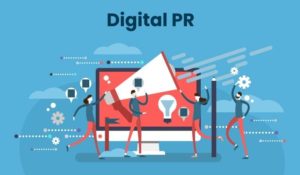PR Is The New Digital Asset
For communications professionals, the shift from old to advanced technology poses both opportunities and risks. The area of public relations is inextricably linked to the publishers, which is, in turn, linked to the exploration and processing of knowledge by businesses and consumers. The shift from offline to online has thrown these sectors into disarray, and conventional public relations is no exception.
They are constantly distinguishing ourselves from the competition in a competitive and saturated environment through their hard work, dedication, and loyalty to their customers.
A digital PR agency has to increase the number of links to clients’ websites. While this might seem to be a simple task, everyone in the business knows that any old way of distributing press releases will not suffice.The aim for each campaign is to obtain reliable, appropriate, and elevated backlinks, but this is never guaranteed. As a result, digital advertisers must find opportunities to increase the probability of clients’ website showing up online.
Digital PR team accomplishes this in part by producing additional content to accompany our engagement presentations and official statements, such as infographics, contributing to the goals, comprehensive research pieces, or indexes.
By utilizing their strange connection with Yahoo Finance and other major outlets including Entrepreneur and Forbes, they will help their clients get featured, interviewed, and promoted to the masses. Building Your Authority’s clients are thriving at a time when so many people are desperate just to stay alive, let alone expand. More podcasts, promotional appearances, and revenue-generating events are being booked than it has ever been.
There’s a lot of talk about sloppy PR practice, which results from practitioners compromising efficiency for pace, resulting in some shoddy results. It’s difficult to see; poorly performed PR jobs, such as inaccurate numbers, obsolete logos, or misplacing people’s names, tarnishes the entire career. Marketing technologies will help with both pace and accuracy, guaranteeing that we’ve protected all of our bases while still being able to participate in timely discussions. Here are three things PR professionals can do ahead of time to prepare, as well as how digital asset management can help.
- Relevant content
The word “right” is important here. We must not only find the most attractive angle to reach the press, but we must also be willing to even provide up-to-date, truthful information that does not damage the company’s image; everything should be aligned with the corporate objectives.
It’s amazing how quickly things can go from good to poor in the world of public relations. There is no going back after anything has been relayed to the press with incorrect or misleading language. This is particularly true in the age of social media, where mistakes can be easily reported and shared through several outlets.
- Eligible people
The most important thing to consider is to first educate your staff. Simply put, your business is made up of your staff. Internally disseminating the latest industry trends and figures is important for increasing brand recognition.
Internal contact is enabled by digital asset management, which means that only the appropriate team have access to data intended for them.
- Appropriate timing
Meeting deadlines is important in the media, as anyone who works in or with it knows. You can miss out on influencing a broad audience if you lose the traction. That’s why it would be a tragedy if you didn’t respond to media inquiries as soon as they were made; otherwise, you avoid being locked out of a significant conversation. A Media Kit should be available on the company’s website at all times. Having a DAM collection of your media materials and incorporating it on your websites is an easy way to get it prepared.
The key benefits of designing evaluation pages for a campaign
- Journalists always connect to campaign pages (rather than a homepage) because they serve as a source for reporters to link to and for people to learn everything.
- You have complete control over internal connection.
- They continue to create ties over time as a result of well-curated content that rates for lengthy keywords.
- They’re easy to share, specifically if they’re primarily targeted and engaging.
- They enable you/your client develop yourself as a thought leader, particularly if the research is information and one-of-a-kind.
There are operational as well as strategic problems. For example, the transition to digital media necessitates the acquisition of a new range of resources to achieve today’s PR objectives. Public relations experts, more than ever, need to acquaint ourselves with a new range of technologies to adapt and succeed in a digital environment.
Here are five resources that every digital pr team should have with them.
- Search Engine Optimization (SEO)
Search is the most common way to find online information. For digital PR practitioners, keyword optimization of news content is a vital method. Press releases, media reports, and multimedia assets like photographs and video are all examples of news content that can be optimized. News content that is optimized for important and common phrases will make it rank higher in search engines. Better search exposure aids marketing campaigns and online credibility, as well as attracting analysts, writers, and bloggers looking to learn more about your business.
- Social Media
Understanding social media connections is a crucial part of every digital PR campaign. Social media is where the people an organization wants to enter or influence spend time and are affected by it. In a digital PR program, social involvement involves communicating with and interacting powerful and consumers to maintain a positive brand image and recognizing and inspiring global brands. Actively optimizing social media content and cultivating connections with customers helps to deflect negative brand awareness while highlighting what’s nice. Being open to and helpful to communities, as well as adhering to both tacit and explicit ‘social laws,’ is important.
- Digital Assets
The video, audio, podcasts, photographs, and several other digital assets available on most online platforms offer multiple chances for pull-based public relations. Financial platforms that are optimized with specific keywords and promoted or submitted to vertical search engines like YouTube and Flickr may provide additional visibility to both media and end customers. In a TopRank survey of journalists and editors, 91 percent of respondents said they use search engines regularly in their work. More than just text content can be optimized for PR, resulting in more points of entry to media content and better search-based exploration.
- Blogging
When done correctly, a company blog can be a fantastic public relations tool. A company blog helps a company to produce and distribute its material to a targeted online audience of content creators. Blog posts that are well-optimized and connected will rank well in search engines, rendering them easy to identify for reporters and journalists looking for stories. When the business being marketed would have its blog to refer to, then the blogger connections are much more fruitful.
With so many copyright holders online, the possibility of both negative and positive product reviews skyrockets. However, there are numerous resources available to assist the online PR professional in effectively monitoring brand credibility. Companies may set up free notifications to track mentions of their brand name, rivals’ names, industry trends, and essential piece names utilizing tools like Google Alerts, Social Mention, or Twitter. Data from social media monitoring could be used to create something new, keep track of rivals, recognize global brands, and easily and explicitly respond to negative press.
Manufacturing companies that concentrate on digital marketing will unlock substantial potential growth. In reality, what businesses claim to be their top priorities is entirely dependent on successful marketing, which includes expanding existing markets, entering new geographies, and launching new goods and services. More content production is credited with an improvement in success by 82 percent of manufacturing marketers. Financial platforms such as pictures, photographs, content, media, and videos are the new currency for marketers in the digital age. These digital assets make it easier for a business and its customers to share value before a transaction is made to increase brand recognition and revenue, sales, distributors, PR, agencies, and contractors need a steady output of product-related material, creative media, and graphics.








 Email: info@cyber-gear.com
Email: info@cyber-gear.com